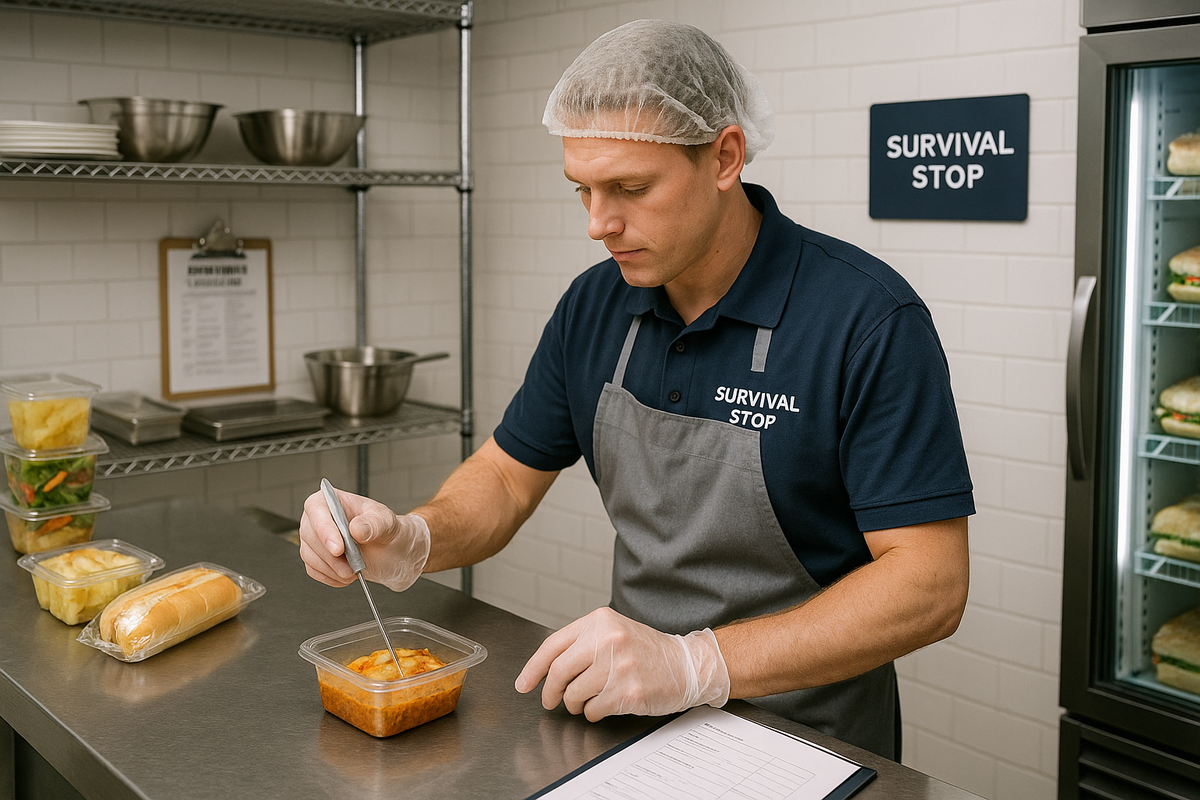Food Safety Guidelines for C-Store Employees
Food safety violations cost the average convenience store $15,000 annually in fines and lost sales. With 87% of c-stores offering prepared food, proper employee training in temperature control, hygiene, and cross-contamination prevention is essential.

Convenience stores across America face increasing scrutiny from health departments as prepared food sales become a larger portion of their revenue streams. Recent industry data shows that food safety violations cost the average convenience store operator $15,000 annually in fines, lost sales, and remediation efforts, making proper employee training essential for both public health and business sustainability.
"Food safety isn't just about avoiding health department visits anymore," explains Maria Santos, who oversees food service operations for twelve Survival Stop locations throughout Florida. "Customers are more aware of food safety practices than ever before, and a single social media post about poor handling can destroy years of reputation building."
The National Association of Convenience Stores reports that 87 percent of convenience stores now offer some form of prepared food, making food safety guidelines for c-store employees a critical operational requirement rather than an optional consideration.
Temperature Control Fundamentals
Temperature monitoring represents the cornerstone of convenience store food safety programs. Hot foods must maintain temperatures above 140 degrees Fahrenheit, while cold items require consistent storage below 40 degrees to prevent bacterial growth that causes foodborne illness.
Temperature logging protocols require employees to check and record food temperatures every two hours during operating periods. Digital thermometers provide accurate readings that must be documented on official temperature logs maintained for health department inspection. These records demonstrate consistent compliance with food safety regulations and help identify equipment problems before they compromise food quality.
Roberto Martinez, who manages food service operations at a high-volume store in suburban Dallas, emphasizes the importance of immediate corrective action when temperature readings fall outside safe ranges. "We've trained our team to never ignore a temperature that's out of range," Martinez explains. "Whether it's adjusting equipment settings or discarding compromised food, quick response prevents small problems from becoming major violations."
Cold storage areas require particular attention since temperature fluctuations affect dairy products, deli meats, and prepared sandwiches that form the backbone of many convenience store food programs. Employees must understand that opening cooler doors frequently or overstocking can create temperature inconsistencies that compromise food safety.
Personal Hygiene and Handwashing Standards
Proper handwashing techniques form the foundation of food safety compliance for convenience store employees. The Food and Drug Administration requires employees to wash hands for at least 20 seconds using warm water and soap before handling food, after using restrooms, following breaks, and when switching between different food preparation tasks.
Handwashing stations must remain fully stocked with soap, paper towels, and hand sanitizer to ensure compliance during busy periods. Employees working with food cannot wear jewelry on hands or wrists and must tie back long hair to prevent contamination during food preparation activities.
Jessica Thompson, training coordinator for a regional convenience store chain in the Pacific Northwest, reports that consistent handwashing enforcement has reduced food safety incidents by 60 percent across their locations. "We make handwashing as automatic as putting on gloves," Thompson notes. "It becomes second nature when properly reinforced during training and daily operations."
Label Rotation and Inventory Management
First-in, first-out inventory rotation prevents expired products from reaching customers while ensuring optimal food quality. Employees must check expiration dates during restocking activities and place newer items behind older products to maintain proper rotation sequences.
Prepared food items require date and time labels indicating when products were made and when they must be discarded. Most convenience store-prepared foods have shelf lives ranging from four to 24 hours, depending on ingredients and preparation methods. Clear labeling systems prevent confusion during busy periods when multiple employees handle food service responsibilities.
Anthony Rodriguez, whose store specializes in fresh sandwiches and salads, credits rigorous labeling practices with maintaining zero food safety violations during five years of operation. "Every item gets labeled with preparation time and discard time," Rodriguez explains. "There's never any question about whether something is still safe to sell."
Hot Food Preparation Protocols
Hot food preparation requires understanding proper cooking temperatures and holding procedures that maintain both safety and quality. Ground beef products must reach internal temperatures of 155 degrees Fahrenheit, while poultry requires 165 degrees for safe consumption.
Equipment calibration ensures that cooking temperatures remain accurate and consistent. Employees must verify that warming units, grills, and fryers maintain proper temperatures before beginning food preparation activities. Digital probe thermometers help confirm that internal food temperatures meet safety requirements during cooking processes.
Glove Usage and Cross-Contamination Prevention
Disposable gloves provide barrier protection when handling ready-to-eat foods, but proper usage requires understanding when gloves must be changed to prevent cross-contamination. Employees must change gloves between handling raw and cooked foods, after touching non-food surfaces, and whenever gloves become torn or contaminated.
Cross-contamination prevention extends beyond glove usage to include separate cutting boards for different food types, designated utensils for specific products, and proper cleaning procedures between food preparation tasks. Raw meat products require separate preparation areas and utensils that never contact ready-to-eat items without thorough cleaning and sanitization.
Samantha Williams, who operates three stores in rural Georgia, emphasizes that cross-contamination prevention requires constant awareness rather than just following rules. "We train employees to think about contamination pathways," Williams explains. "Understanding how bacteria spread helps them make better decisions during busy periods when procedures might get rushed."
Equipment Sanitization and Maintenance
Regular equipment cleaning and sanitization prevent bacterial buildup that can contaminate food products. Three-compartment sinks provide proper washing, rinsing, and sanitizing capabilities for utensils and small equipment items that cannot be cleaned in commercial dishwashers.
Sanitizing solutions must maintain proper chemical concentrations to effectively eliminate harmful bacteria. Test strips verify that sanitizer strength remains within acceptable ranges throughout operating periods. Equipment surfaces that contact food require cleaning and sanitizing every four hours during continuous use.
Training Implementation and Compliance
Effective food safety training programs combine initial instruction with ongoing reinforcement that maintains consistent compliance across all shifts and employees. New hire training must cover all food safety guidelines before employees begin handling food products independently.
Regular refresher training addresses specific issues observed during daily operations and incorporates updates to food safety regulations. Many successful convenience store operators conduct monthly food safety meetings that reinforce proper procedures while addressing questions about specific situations.
Food safety guidelines for c-store employees represent essential knowledge that protects public health while safeguarding business operations from costly violations and reputation damage. Operators who invest in comprehensive training and consistent enforcement typically maintain superior food safety records while building customer confidence in their prepared food offerings.





